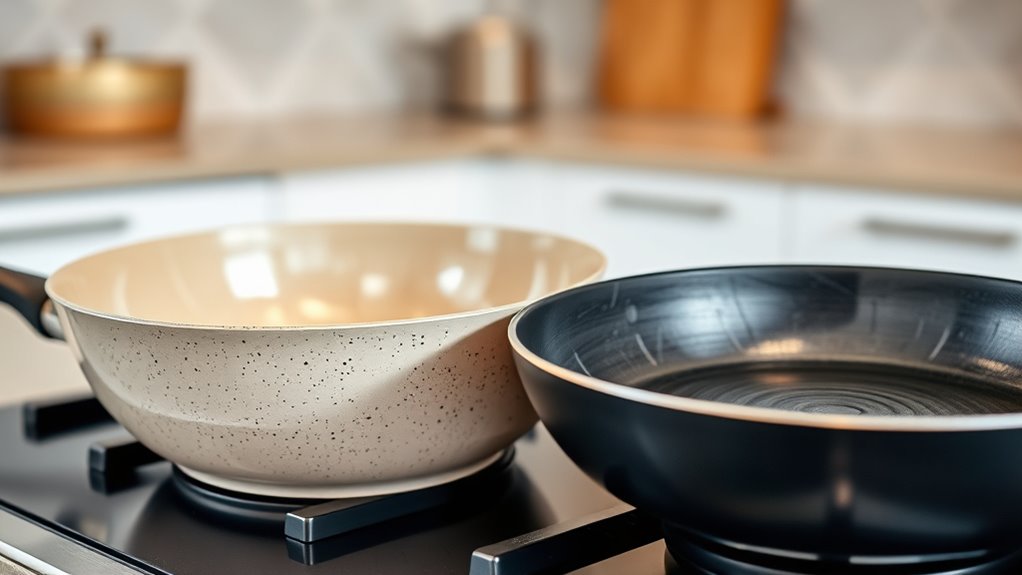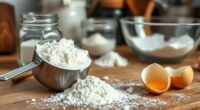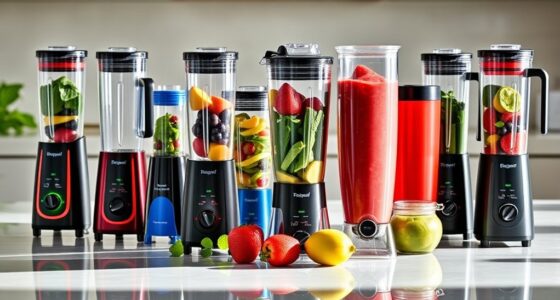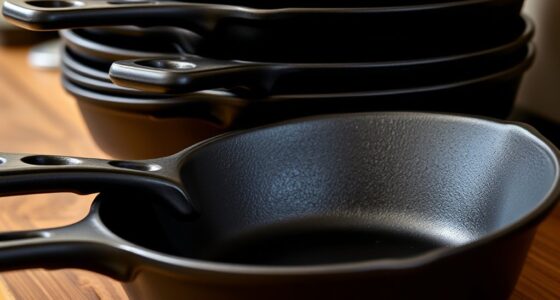When choosing between ceramic and Teflon cookware, consider safety, durability, and environmental impact. Teflon pans offer excellent non-stick performance but can release toxic fumes if overheated or scratched over time. Ceramic coatings are free from harmful chemicals, withstand higher temperatures, and last longer with proper care. If you want a safer, eco-friendly option, ceramic may suit you better. To learn more about their differences and practical tips, keep exploring this comparison.
Key Takeaways
- Ceramic cookware is PTFE and PFOA free, offering safer high-temperature cooking compared to Teflon, which can release toxic fumes when overheated.
- Teflon coatings typically last 1-3 years, while ceramic lasts 2-5 years with proper care; durability depends on handling and utensil use.
- Ceramic surfaces withstand higher temperatures (up to 572°F) and distribute heat more evenly than Teflon, suitable for searing and high-heat cooking.
- Manufacturing of Teflon emits significant CO₂ and involves chemicals that can pollute, whereas ceramic production has a lower environmental impact.
- Proper maintenance—gentle cleaning and avoiding metal utensils—extends both coatings’ lifespan and ensures safe, effective non-stick performance.
Understanding the Composition of Ceramic and Teflon Coatings
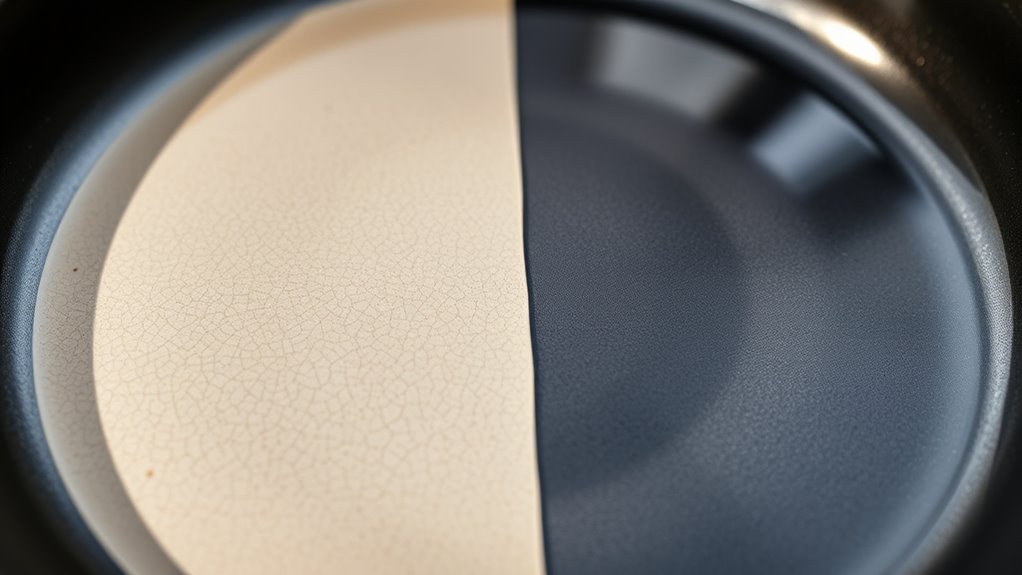
To understand how ceramic and Teflon coatings work, it’s important to know their compositions. Teflon coatings are made from PTFE, a fluoropolymer known for its exceptional nonstick surface. PTFE’s chemical structure features long carbon chains surrounded by fluorine atoms, which gives it low friction and heat resistance. These coatings are layered with multiple thin layers to boost durability but can degrade over time. The industry trend shows increasing consumer demand for safer cookware options, which influences the development of ceramic coatings. Ceramic coatings, on the other hand, consist of silica nanoparticles applied via a sol-gel process, creating a natural, non-toxic nonstick surface. Unlike Teflon, ceramic coatings are free from PTFE and PFOA, making them safer for health and the environment. Additionally, the thermal stability of ceramic coatings allows them to withstand higher temperatures without degrading compared to Teflon coatings. Furthermore, advances in coating technology continue to improve the longevity and performance of ceramic surfaces. These technological improvements also enhance the adhesion strength of ceramic coatings, contributing to their durability. Moreover, the compatibility with various cooktops makes ceramic coatings a versatile choice for different types of stoves and heat sources.
Performance and Heat Resistance in Daily Cooking
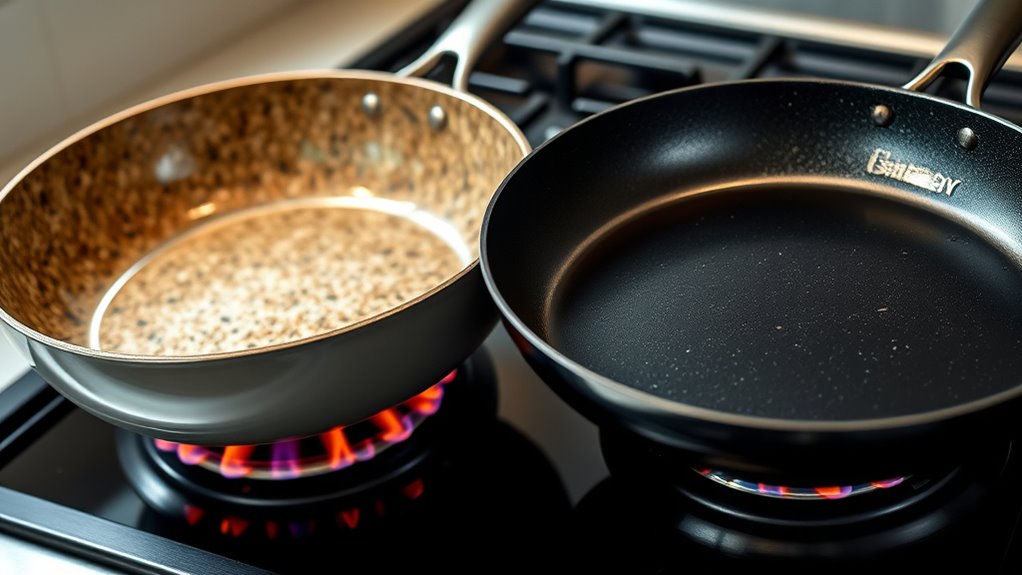
When it comes to daily cooking, understanding how ceramic and Teflon coatings handle heat can make a significant difference in your results. Teflon (PTFE) coatings typically withstand temperatures up to 500°F, making them suitable for low to medium heat tasks, but overheating releases toxic fumes. Ceramic cookware, on the other hand, offers better heat resistance, often up to 572°F, allowing more versatile high-temperature cooking. Its even heat distribution and heat retention support slow-cooking and searing. Keep in mind:
- Ceramic coatings tolerate higher temperatures without degrading
- Teflon’s non-stick surface can degrade under high heat
- Aluminum cores in Teflon pans heat quickly, risking overheating
- Ceramic’s thermal performance excels at high temperatures and long-lasting durability
- Awareness of frost-free technology can help in maintaining the longevity of your cookware and plumbing systems.
Additionally, ceramic coatings are often considered more environmentally friendly compared to traditional Teflon, which involves the use of potentially harmful chemicals during manufacturing.
Durability and Long-Term Wear of Non-Stick Surfaces

Your non-stick cookware’s surface will wear over time, with Teflon lasting about 1-3 years and ceramic around 2-5 years. Using metal utensils or cleaning abrasively accelerates this deterioration, reducing its effectiveness. Regularly inspecting for chips or scratches helps you know when the coating’s performance has declined markedly. Additionally, understanding the durability of non-stick surfaces can help you choose the best cookware for long-term use. Incorporating sound healing science insights into your maintenance routine may even promote better longevity of the coating. Proper care and maintenance of non-stick cookware, such as hand washing and avoiding high heat, can further extend its lifespan. Implementing proper cleaning techniques ensures the coating remains intact and effective over time. Continuous monitoring of AI behavior is essential for maintaining safety and effectiveness, especially given the vulnerabilities to jailbreaking techniques identified in advanced models.
Coating Lifespan and Wear
Both Teflon and ceramic nonstick coatings gradually wear down over time, with their durability largely depending on usage and care. The non-stick lifespan varies: PTFE coating like Teflon typically lasts 1 to 3 years, while ceramic nonstick may need replacement after 1 to 2 years due to surface degradation. Proper handling can extend coating wear, but scratches from metal utensils accelerate deterioration. Once chips or scratches appear, nonstick performance declines, and replacement becomes necessary. Keep in mind:
- Surface degradation reduces non-stick effectiveness
- Scratches compromise coating integrity
- PTFE coatings tend to last longer with proper care
- Ceramic nonstick wears out faster, especially with improper use
- Coating durability is influenced by the quality of materials and manufacturing processes used in the cookware. Regular maintenance and gentle cleaning can help preserve the coating for a longer period, emphasizing the importance of proper cookware care practices.
Understanding coating wear helps you choose and maintain cookware to maximize its lifespan and safety.
Impact of Utensil Use
The type of utensils you use can markedly influence the durability and lifespan of non-stick cookware. Metal utensils, for example, can scratch and damage nonstick coatings, leading to chips, peeling, and reduced effectiveness. Ceramic nonstick surfaces resist scratches better but still degrade faster with rough handling. To preserve your nonstick surface, choosing the right utensils is essential. Silicone, wood, or plastic tools are gentler options that prevent scratches and extend the life of your cookware. Proper handling also matters—avoid force or scraping. Additionally, understanding the impact of utensil material on non-stick surfaces can help you make better choices for long-term use. Recognizing the wear and tear factors that affect non-stick coatings can further assist in maintaining their effectiveness over time. Using proper cleaning techniques to avoid abrasive cleaners can also prolong the lifespan of your non-stick cookware.
Maintenance and Repair Challenges
Maintaining non-stick cookware over time presents notable challenges because the coatings naturally wear off over time. As you use your cookware, micro-scratches and wear patterns develop, reducing non-stick effectiveness and increasing the risk of peeling or flaking. Scratches from metal utensils or abrasive cleaners accelerate this degradation, making maintenance more difficult. Once the non-stick surface shows signs of peeling, chipping, or significant scratches, repair becomes impossible, and replacement is often necessary. To prolong lifespan, you should:
- Hand wash gently
- Use wooden or silicone utensils
- Avoid high heat
- Inspect regularly for damage
- Be aware that security vulnerabilities in new technologies can compromise your cookware’s digital features if applicable.
Despite proper maintenance, non-stick coatings ultimately degrade, making longevity a key concern. Recognizing when repair is no longer feasible helps ensure safety and peak performance. Additionally, understanding the durability of different coatings can inform better maintenance practices to extend the lifespan of your cookware. Regularly checking for signs of wear and understanding the coating composition can help you decide when it’s time to replace your cookware to maintain safety and efficiency.
Safety Concerns and Chemical Exposure Risks

Overheating Teflon-coated pans can release toxic fumes containing PFOA, which pose respiratory risks known as “Teflon flu.” Scratched or deteriorating nonstick coating may lead to chemical leaching, introducing microplastics and nanoplastics into your food, raising long-term health concerns. Teflon’s PFOA has been linked to health risks like thyroid issues, kidney and liver problems, and hormonal disruption. Even though the EPA phased out PFOA, worries remain about fluoropolymers like GenX, which may have similar toxicity. Ceramic cookware, on the other hand, is free from PTFE and PFOA, eliminating risks associated with toxic fumes and chemical leaching. Choosing ceramic reduces your exposure to harmful chemicals and offers a safer alternative for your health. Cookies and Privacy policies highlight the importance of understanding product safety and user health considerations when selecting cookware materials.
Environmental Impact and Sustainability Factors

You might notice that traditional Teflon coatings release harmful chemicals like PFOA during production and use, contributing to pollution and health concerns. In contrast, ceramic cookware, made from natural materials, generally has a lower environmental footprint and fewer emissions. Considering durability and waste, ceramic options often last longer and are easier to recycle, reducing overall environmental impact. Additionally, understanding the refrigeration cycle can help consumers choose more energy-efficient cookware options that minimize environmental harm.
Chemical Pollution Concerns
Chemical pollution from nonstick cookware raises significant environmental concerns. Traditional Teflon (PTFE) coatings contain PFOA and other PFAS chemicals, which are persistent in the environment and linked to health risks. When these pans degrade or are scratched, toxic chemicals can leach into food and ecosystems. Manufacturing processes also emit greenhouse gases, exacerbating climate change. Disposal of nonstick pans releases microplastics and nanoplastics, polluting water sources and harming wildlife. In contrast, ceramic cookware made from natural materials offers a more eco-friendly option, with lower chemical risks. Consider these points:
- PFOA and PFAS are linked to environmental pollution and health issues
- Microplastics from degraded nonstick pans contaminate ecosystems
- Toxic chemicals persist in water, wildlife, and humans
- Ceramic cookware minimizes chemical pollution and is more sustainable
Manufacturing Emissions Impact
Ever wonder how the manufacturing of nonstick cookware impacts the environment? PTFE-based Teflon coatings generate significant manufacturing emissions, with some facilities releasing CO₂ comparable to that of 125,000 cars annually. This contributes to the overall environmental impact, especially through chemical pollution linked to PFOA and PTFE, which can contaminate waterways and bioaccumulate. In contrast, ceramic cookware, made from natural silica and fired clay, involves simpler, more eco-friendly manufacturing processes, resulting in lower emissions. While fluoropolymer alternatives like GenX aim to reduce pollution, they still pose environmental concerns. Overall, ceramic cookware tends to produce fewer manufacturing emissions and has a smaller environmental footprint, making it a more eco-friendly choice for sustainability-minded consumers.
Durability and Waste
Since Teflon-coated pans tend to wear out faster—usually after 1 to 3 years—they need to be replaced more frequently than ceramic cookware, which can last 2 to 5 years with proper care. This shorter lifespan increases waste and raises environmental concerns. Frequent disposal of Teflon pans contributes to landfill accumulation and environmental pollution. Ceramic cookware, being more durable and long-lasting, reduces waste over time. To maximize durability and minimize environmental impact, consider these points:
- Longer lifespan decreases frequency of replacement
- Less waste generated with durable cookware
- Eco-friendly ceramic production reduces ecological footprint
- Proper care extends the wear and lifespan of ceramic pans
Choosing ceramic helps you reduce waste and lessen disposal-related environmental impact.
Proper Care and Maintenance for Longevity

To guarantee your ceramic or Teflon nonstick cookware lasts as long as possible, it’s essential to handle and clean them properly. Proper care and maintenance help preserve the nonstick surface and extend its longevity. Always hand wash your cookware with a non-abrasive sponge to prevent scratches that could lead to damage. Use low to medium heat settings, as high temperatures can wear down the coating over time. Avoid metal utensils entirely; opt for silicone, wood, or plastic tools to protect the surface. Never put nonstick cookware in the dishwasher, as harsh detergents and jostling can degrade the coating. Regularly inspect for chips or scratches—once damage appears, replace the pan to avoid ingesting coating particles and to maintain *ideal* performance.
Making an Informed Choice Based on Lifestyle and Values

Choosing the right nonstick cookware depends on your lifestyle and values, as these factors influence which features matter most to you. If health concerns and environmental impact are priorities, ceramic nonstick cookware is a great choice because it’s non-toxic and eco-friendly. Teflon pans, on the other hand, offer better durability and superior nonstick performance but pose chemical exposure risks if overheated or scratched. Your lifestyle choices—such as cooking at high heat frequently or valuing sustainability—will guide your decision. Consider these points:
- Ceramic nonstick cookware aligns with health-conscious and eco-friendly values
- Teflon pans suit quick, easy cleanup routines and long-lasting use
- Durability may be less with ceramic but safer regarding health concerns
- Environmental impact influences the preference for ceramic options over Teflon
Matching your priorities helps you select the best cookware for your habits.
Frequently Asked Questions
Which Is Better, Teflon or Ceramic Non-Stick?
When choosing between Teflon and ceramic non-stick cookware, you should consider safety and durability. Teflon offers excellent non-stick performance and is more durable but can release toxic fumes if overheated. Ceramic is safer and environmentally friendly, though it may wear out faster and requires gentle handling. Ultimately, pick what suits your cooking style and safety preferences, balancing longevity with health considerations.
What Is the Healthiest Nonstick Cookware to Use?
You might think all nonstick cookware is risky, but ceramic options are actually healthier. They’re free from harmful chemicals like PTFE and PFOA, so you won’t worry about toxic fumes or carcinogens while cooking. Plus, ceramic handles higher temperatures safely, making them a safer choice for everyday use. With proper care, ceramic cookware lasts longer and keeps your meals healthier, making it the best nonstick option for your kitchen.
What Is the Best Coating for Non Stick Pans?
When choosing the best coating for non-stick pans, consider your safety and durability needs. Teflon offers excellent release and long-lasting performance but can emit toxic fumes if overheated. Ceramic coatings are non-toxic, safer at high temperatures, and scratch-resistant, but may wear faster. Think about how often you’ll cook, your safety concerns, and maintenance preferences to pick the coating that suits your cooking style best.
What Are the Pros and Cons of Ceramic Non Stick Pans?
Pros and cons of ceramic nonstick pans paint a perfect picture of practicality. You get safer, more sustainable surfaces that withstand high heats and promise durability with proper care. However, you must mind their fragility—scratches and wear can quickly diminish nonstick properties. While they’re eco-friendly and toxin-free, they tend to cost more and may need replacing sooner, making them a balanced choice between beauty and brief lifespan.
Conclusion
So, now you get to choose between ceramic and Teflon—each promising non-stick perfection. Ironically, your quest for easy cooking might come with hidden trade-offs, whether it’s durability or safety concerns. In the end, it’s all about balancing your values and lifestyle. Whichever you pick, just remember: the perfect non-stick surface might be more about your patience than the coating itself. Happy cooking, and may your pans stick to your story, not your food!
